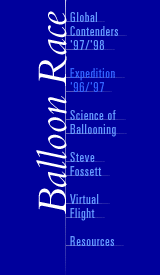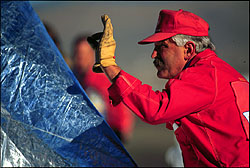 |
 |
Interview with
|
|
Erickson via RealAudio: 14.4 | 28.8 | ISDN Get RealAudio software |
 ERICKSON: We have to dig a hole in the ground, approximately three feet
by three feet by three feet, and we have to fill it up with concrete and put a
foot of reinforcing bar—half-inch reinforcing bar sticking out of the ground
in the shape of a "U" so that we can attach some winches. Sixteen winches.
Synchronized winches. ERICKSON: We have to dig a hole in the ground, approximately three feet
by three feet by three feet, and we have to fill it up with concrete and put a
foot of reinforcing bar—half-inch reinforcing bar sticking out of the ground
in the shape of a "U" so that we can attach some winches. Sixteen winches.
Synchronized winches. The engineers have decided that the proper way to launch this balloon is to launch it vertically, rather than to lift it up horizontally over the top of the capsule, which we had intended to have on the launch pad and so on...So now, we're going to remove all the hardware that we'd poured in there last year and we're going to use a launch vehicle and we'll actually inflate the balloon over the pad, held down by sixteen winches and we'll roll the entire capsule with its propane tanks complete, ready to fly, everything loaded on board—food, water, everything, and we will roll the capsule under the balloon, under the rigging, and then we will pull the balloon back down with these sixteen synchronized winches. And we will attach the fly wires and we will proceed to fill the balloon with the remaining helium, which will take another three or four hours. NOVA: And how long is this whole process? ERICKSON: It will probably seem like forever. That whole sequence should probably take three hours, maybe less, considering the balloon is all laid out. I think it shouldn't take us very long at all. We'll probably start at 5:00 in the evening and we'll, maybe, be ready at dawn to pull the trigger. NOVA: For launch, what are your ideal local weather conditions? |
|
Erickson via RealAudio: 14.4 | 28.8 | ISDN |
ERICKSON: Well, the local conditions are dead calm. We would like to
have a high pressure set in over Morocco. We would like to have zero to three
mile-an-hour winds for a three-day period. Our procedure will require at least
two days of active work on the launch site. We don't want to have to stop and
haul things back into the hanger because rain is coming. The whole outlook of this is we have never, and we will never consider to inflate the balloon, get everything ready and not launch. We don't have anything built into the scenario to hold our flight. So what we would like is a completely clear, clean weather pattern for 72 hours, at which time, we will be busily making final preparations on the capsule. In 48 hours, we will move the capsule out onto the launch vehicle, at the end of this runway, out of the way of the balloon. We will have a team that will be loading and completing electronics checking, loading the food, the ballast, all of that. And then, we will—24 hours before, we will haul the balloon. We will lay out the plastic. We will, in fact, lay the balloon out, fluff it up so that its crown is in the center of the launch area, and we will prepare to be ready in the afternoon so that will take a brief break, we will change our clothes, we will get ready, have something to eat and then, at 5:00, 6:00, we'll go out and start the launch procedure and start the inflation. That's the key to the whole project. At this time, I mean, even if we have a little fluffs coming through at 72 hours—I say, wind, fluffs, I hope that they will die down. We know that we can't get it perfectly calm. We'll have meteorologists and other people that will be reading. We have readings for a year now of local air movements. We know that we have spikes of wind in the middle of the night, 2:00 in the morning-ish, but in fact, we do know that with this type of launch that we're going to have, this balloon will be safe, relatively speaking, to some of these little blusters that come through. NOVA: What is the most critical moment at launch? ERICKSON: Well, the critical moment at launch is when we push the launch cutters. We push the fire button to cut them away. That, until they reach five to ten thousand feet, is the most dangerous time that they'll have. Because if anything goes wrong at those low altitudes, they may not be able to parachute out. NOVA: Is your job done then, at that moment that the cutters fire? ERICKSON: Well, I know I'm going to do what I always do after a launch, I usually help clean up a bit. I get in my truck and go home and I go to bed and I wait for the phone to ring. I mean, I pray that it doesn't happen this time. They've asked me to stay on at Marakech for four days, three or four days, and now we go into a different mode. It will be just a safety thing. I will stay in Marakesh until they clear the Mediterranean, at which point, I will go up to London because I'll be part of the group—should they go down anywhere prior to finalizing their flight all the way around the world, we'll have to go out and help package it up and bring it home. NOVA: You'll be picking up the pieces. ERICKSON: The piece. (laughter) Should they land on land. Interviews: Ackroyd | Branson | Erickson | Eversfield | Kendrick Photos: Aaron Strong Global Contenders '97/'98 | Expedition '96/'97 | Fossett | Virtual Flight Science of Ballooning | Teacher's Guide | Resources | Transcript | Balloon Home Editor's Picks | Previous Sites | Join Us/E-mail | TV/Web Schedule About NOVA | Teachers | Site Map | Shop | Jobs | Search | To print PBS Online | NOVA Online | WGBH © | Updated October 2000 |

 NOVA: So, Bruce, tell us how one becomes a launch master for a project
like this.
NOVA: So, Bruce, tell us how one becomes a launch master for a project
like this.